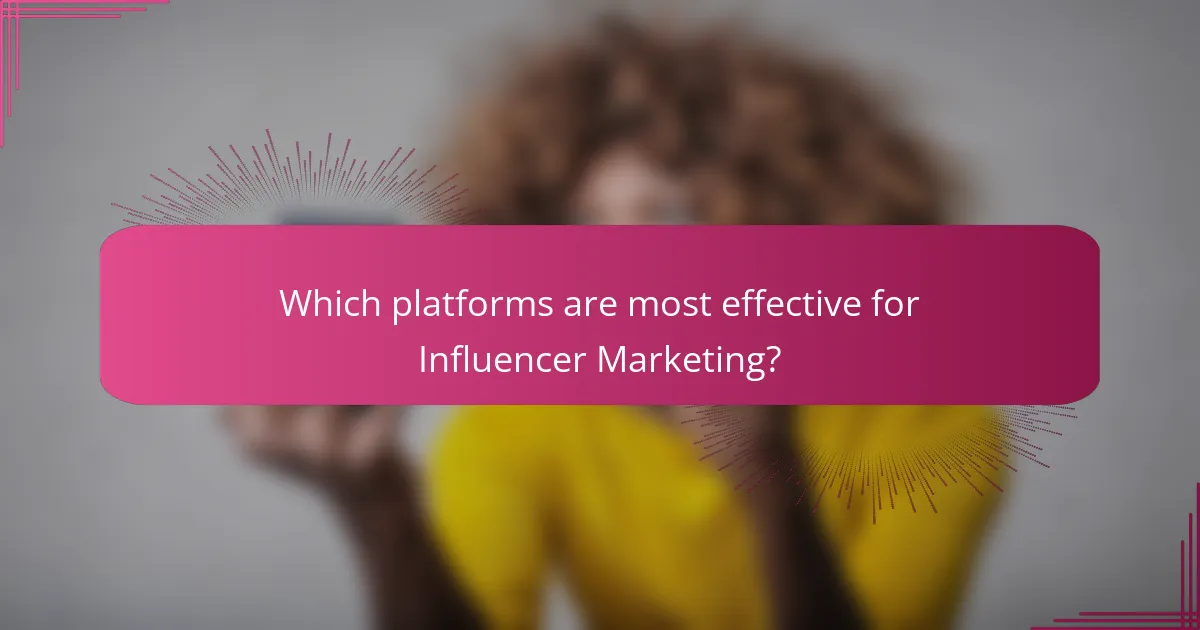Influencer marketing is a strategic approach where brands collaborate with influential individuals to promote products or services, leveraging the trust these influencers have established with their followers. Key strategies in this domain include influencer partnerships, content co-creation, and affiliate marketing, all aimed at enhancing brand awareness and driving sales. Research indicates that a significant percentage of consumers rely on influencer recommendations for their purchasing decisions, with platforms like Instagram, YouTube, and TikTok emerging as the most effective channels for these marketing efforts. The article explores the growth of influencer marketing, detailing its strategies, effectiveness, and the advantages of utilizing various social media platforms.

What is Influencer Marketing?
Influencer marketing is a strategy that involves partnering with influential individuals to promote products or services. Brands leverage these influencers’ reach and credibility to connect with their target audience. This approach capitalizes on the trust that influencers have built with their followers. Research indicates that 49% of consumers depend on influencer recommendations when making purchase decisions. Additionally, influencer marketing can yield an average return of $5.78 for every dollar spent. This demonstrates its effectiveness in driving sales and brand awareness.
How has Influencer Marketing evolved over the years?
Influencer marketing has evolved significantly over the years. Initially, it relied on celebrities endorsing products through traditional media. As social media emerged, micro-influencers gained traction due to their authentic connections with niche audiences. In 2016, a study by the Digital Marketing Institute found that 49% of consumers depend on influencer recommendations. This shift highlighted the importance of trust and relatability over celebrity status. Today, brands leverage data analytics to measure influencer effectiveness and ROI. Platforms have also diversified, with TikTok and Instagram becoming key players. The landscape continues to adapt, integrating new technologies like AI for targeted marketing.
What are the key milestones in the history of Influencer Marketing?
Influencer marketing has evolved significantly over the years. In the 2000s, brands began collaborating with bloggers to reach niche audiences. This marked the initial recognition of individuals as influential figures. The rise of social media platforms in the 2010s accelerated this trend. Instagram’s launch in 2010 allowed influencers to showcase products visually. By 2015, influencer marketing became a formal strategy for many brands. Research indicated that businesses earned $6.50 for every dollar spent on influencer marketing. The introduction of micro-influencers in the late 2010s shifted focus to smaller, engaged audiences. Today, influencer marketing continues to grow, adapting to new platforms and audience preferences.
What factors have contributed to the rise of Influencer Marketing?
The rise of Influencer Marketing is primarily attributed to the growth of social media platforms. These platforms have provided a space for influencers to connect with large audiences. Additionally, consumers increasingly trust recommendations from individuals over traditional advertising. A study by Nielsen found that 92% of consumers trust recommendations from people they know. The accessibility of content creation tools has also empowered more individuals to become influencers. Furthermore, brands recognize the high engagement rates associated with influencer partnerships. According to a report by Influencer Marketing Hub, businesses earn an average of $5.78 for every dollar spent on influencer marketing. Lastly, the shift towards authentic and relatable brand messaging has made influencer marketing a preferred strategy for many companies.
Why is Influencer Marketing important for brands?
Influencer marketing is important for brands because it enhances brand visibility and credibility. Influencers have established trust with their audience. This trust translates into higher engagement rates for brand promotions. According to a study by Nielsen, 92% of consumers trust recommendations from individuals over brands. Influencer marketing also allows brands to target specific demographics effectively. It reaches audiences that traditional advertising may not. Additionally, influencer partnerships can lead to increased sales. A report by Influencer Marketing Hub indicates that businesses earn an average of $5.78 for every dollar spent on influencer marketing.
How does Influencer Marketing enhance brand visibility?
Influencer marketing enhances brand visibility by leveraging the reach and credibility of influencers. Influencers have established trust with their audiences. This trust translates to higher engagement rates for brands they promote. According to a study by Nielsen, 92% of consumers trust recommendations from individuals over brands. Influencers can create authentic content that resonates with their followers. This authenticity helps brands connect with target demographics effectively. Additionally, influencer marketing can increase social media presence significantly. Brands can gain followers and engagement through influencer collaborations. In 2021, brands earned an average of $5.78 for every dollar spent on influencer marketing, demonstrating its effectiveness in enhancing visibility.
What role does trust play in Influencer Marketing effectiveness?
Trust is a critical factor in Influencer Marketing effectiveness. When audiences perceive influencers as trustworthy, they are more likely to engage with their content. High trust levels lead to increased brand credibility and consumer loyalty. According to a 2021 study by the Digital Marketing Institute, 70% of consumers are more likely to purchase from brands endorsed by influencers they trust. Trust fosters authentic connections between influencers and their followers. This authenticity translates into higher engagement rates and better conversion metrics. Brands that partner with trusted influencers see a significant return on investment. Thus, trust directly impacts the overall success of influencer marketing campaigns.

What are the main strategies used in Influencer Marketing?
The main strategies used in influencer marketing include influencer partnerships, content co-creation, and affiliate marketing. Influencer partnerships involve brands collaborating with influencers to promote products or services. These partnerships are often based on the influencer’s audience and niche. Content co-creation allows brands and influencers to develop engaging content together. This strategy enhances authenticity and reach. Affiliate marketing encourages influencers to share unique referral links for commissions on sales. This method incentivizes influencers to drive conversions. Research shows that 49% of consumers depend on influencer recommendations for purchase decisions. These strategies are effective in increasing brand awareness and engagement.
How do brands identify the right influencers?
Brands identify the right influencers by analyzing audience alignment, engagement metrics, and content relevance. They assess whether an influencer’s audience matches their target demographic. Engagement metrics, such as likes, comments, and shares, indicate how actively an influencer’s audience interacts. Content relevance ensures the influencer’s themes resonate with the brand’s message. Brands also consider the influencer’s authenticity and credibility in their niche. Tools like social media analytics platforms help brands measure these factors efficiently. Research shows that 60% of marketers prioritize audience engagement over follower count when selecting influencers. This data reinforces the importance of strategic selection in influencer marketing.
What criteria should brands consider when selecting influencers?
Brands should consider audience alignment when selecting influencers. The influencer’s audience should match the brand’s target demographic. Engagement rates are also crucial; higher engagement indicates a more active audience. Authenticity is another important factor; influencers should have a genuine connection with their followers. Content quality matters as well; brands should evaluate the influencer’s content style and aesthetics. Previous collaboration success can provide insights into the influencer’s effectiveness. Lastly, the influencer’s values should align with the brand’s mission to ensure a cohesive partnership.
How can brands evaluate an influencer’s audience engagement?
Brands can evaluate an influencer’s audience engagement by analyzing metrics such as likes, comments, shares, and overall interaction rates. These metrics provide insight into how actively the audience engages with the content. Brands should also consider the quality of comments, as meaningful interactions indicate a deeper connection. Additionally, brands can use tools like social media analytics to track engagement trends over time. Research shows that posts with higher engagement rates typically lead to better brand visibility and trust. For instance, according to a study by HubSpot, posts with 1,000 to 5,000 followers have an average engagement rate of 3.5%. This data supports the effectiveness of measuring engagement through these metrics.
What types of content do influencers create?
Influencers create various types of content, including images, videos, blogs, and podcasts. Visual content, such as photos and graphics, is commonly shared on platforms like Instagram. Video content, including tutorials and vlogs, is popular on YouTube and TikTok. Influencers also write blogs that provide insights, reviews, and personal stories. Podcasts allow influencers to share discussions and interviews with audiences. Each content type engages followers differently, using unique formats to convey messages. This diversity helps influencers connect with various audience demographics effectively.
How does content type influence audience engagement?
Content type significantly influences audience engagement by determining how effectively information is conveyed. Different content types, such as videos, blog posts, and infographics, cater to varied audience preferences. For instance, videos have been shown to generate 1200% more shares than text and images combined, enhancing engagement rates. Blog posts allow for in-depth exploration of topics, fostering a deeper connection with the audience. Infographics simplify complex information, making it easily digestible and shareable. Research indicates that 65% of people are visual learners, highlighting the importance of visual content in engagement. Overall, the choice of content type directly affects how audiences interact with and respond to marketing messages.
What are the best practices for creating compelling influencer content?
To create compelling influencer content, focus on authenticity and engagement. Authenticity builds trust with the audience. Engaging content resonates more deeply and encourages interaction. Utilize high-quality visuals to capture attention. Clear messaging should convey the brand’s values and purpose. Collaborate closely with influencers to ensure alignment with their style. Tailor content to the platform’s audience for maximum impact. Use data analytics to track performance and adjust strategies accordingly. These practices enhance the effectiveness of influencer marketing campaigns.

Which platforms are most effective for Influencer Marketing?
Instagram, YouTube, and TikTok are the most effective platforms for influencer marketing. Instagram boasts over 1 billion monthly active users, making it a prime space for brand partnerships. YouTube’s video content allows for in-depth storytelling, engaging audiences effectively. TikTok’s short-form videos have rapidly gained popularity, especially among younger demographics. Research indicates that 70% of teenagers trust influencers more than traditional celebrities. Brands report higher engagement rates on these platforms compared to others. For example, Instagram posts with influencers can achieve engagement rates of up to 3.5%.
What social media platforms are best suited for Influencer Marketing?
Instagram, YouTube, and TikTok are the best social media platforms for influencer marketing. Instagram is highly visual and supports influencer engagement with its Stories and Reels features. YouTube allows for longer content, making it ideal for detailed product reviews and tutorials. TikTok’s short-form videos drive viral trends and have a younger audience.
According to a 2023 survey by HubSpot, 78% of marketers find Instagram to be the most effective platform for influencer collaborations. YouTube follows closely, with 70% of marketers valuing its reach and engagement. TikTok’s popularity has surged, with 60% of marketers planning to increase their budget for this platform.
These statistics highlight the effectiveness of these platforms in reaching and engaging target audiences through influencer marketing.
How does audience demographics vary across different platforms?
Audience demographics vary significantly across different platforms. Each social media platform attracts distinct user groups based on age, gender, location, and interests. For instance, Instagram has a younger audience, with 67% of users aged 18-29. In contrast, Facebook appeals to a broader age range, with 62% of users aged 30-49. LinkedIn is primarily used by professionals, with 51% of users holding a college degree. TikTok is dominated by Gen Z, with 60% of its users aged 16-24. These demographic differences influence marketing strategies. Brands must tailor their content to resonate with the specific audience of each platform. Understanding these variations enhances targeting effectiveness in influencer marketing.
What unique features do these platforms offer for influencer campaigns?
Influencer marketing platforms offer unique features such as advanced analytics tools, which allow brands to measure campaign performance in real-time. These tools provide insights into engagement rates, audience demographics, and ROI. Additionally, many platforms include influencer discovery features that utilize algorithms to match brands with relevant influencers based on niche and audience alignment. This targeted approach enhances campaign effectiveness. Some platforms also offer content approval workflows, ensuring that brands maintain control over messaging and branding. Furthermore, many platforms provide payment processing solutions, simplifying the financial transactions between brands and influencers. These features collectively streamline the influencer marketing process and enhance collaboration efficiency.
How can brands measure the effectiveness of their Influencer Marketing campaigns?
Brands can measure the effectiveness of their Influencer Marketing campaigns through various metrics. Key performance indicators (KPIs) include engagement rates, reach, and conversion rates. Engagement rates show how well the audience interacts with the content. Reach indicates the total number of unique users who see the campaign. Conversion rates reflect the percentage of users who take the desired action, such as making a purchase.
Additionally, brands can use tracking tools to analyze traffic generated from influencer posts. Google Analytics is commonly used for this purpose. It helps brands understand user behavior and source of traffic. Social media platforms also provide analytics tools to track performance. These tools can show likes, shares, and comments on influencer content.
Surveys can be conducted to gather feedback from the audience. This helps brands understand the impact of influencer campaigns on brand perception. Overall, combining these methods provides a comprehensive view of campaign effectiveness.
What key performance indicators should brands track?
Brands should track key performance indicators (KPIs) such as engagement rate, conversion rate, and reach. Engagement rate measures interactions like likes, comments, and shares relative to total followers. This indicates how well content resonates with the audience. Conversion rate tracks the percentage of users who complete a desired action, such as making a purchase. This helps assess the effectiveness of marketing campaigns. Reach quantifies the total number of unique users who see the content. This metric is crucial for understanding audience exposure. Other important KPIs include click-through rate (CTR), which measures the effectiveness of calls to action, and return on investment (ROI), which evaluates the financial return from marketing efforts. Tracking these KPIs enables brands to optimize their influencer marketing strategies effectively.
How can brands assess return on investment (ROI) from influencer partnerships?
Brands can assess return on investment (ROI) from influencer partnerships by tracking specific metrics. Key metrics include engagement rates, reach, and conversions. Brands can analyze the cost of the partnership against the revenue generated. For example, if a partnership costs $5,000 and generates $20,000 in sales, the ROI is 300%. Tools like Google Analytics can help track website traffic from influencer links. Additionally, brands can use unique discount codes to measure direct sales attributed to influencers. Surveys can also gather consumer feedback on purchase motivations linked to influencer promotions. These methods provide concrete data to evaluate the effectiveness of influencer partnerships.
What are the emerging trends in Influencer Marketing?
Emerging trends in influencer marketing include a shift towards micro and nano influencers. Brands increasingly recognize the high engagement rates these smaller influencers can generate. Authenticity is becoming a priority, with consumers favoring genuine connections over polished content. Video content, especially short-form formats like TikTok, is gaining traction. Live streaming is also on the rise, allowing real-time interaction between influencers and audiences. Brands are leveraging data analytics to measure the effectiveness of influencer partnerships more accurately. Additionally, there is a growing emphasis on long-term collaborations rather than one-off campaigns. These trends reflect the evolving landscape of consumer behavior and technology in marketing strategies.
How are technological advancements shaping Influencer Marketing?
Technological advancements are significantly shaping influencer marketing by enhancing targeting capabilities and improving engagement metrics. Advanced algorithms analyze user behavior, enabling brands to identify the right influencers for their audience. Social media platforms now offer sophisticated analytics tools, allowing marketers to track campaign performance in real-time. Artificial intelligence is being used to predict trends and optimize content strategies. Additionally, augmented reality and virtual reality are creating immersive experiences that influencers can leverage. According to a 2022 report by Statista, 67% of marketers believe that technology has improved their influencer marketing strategies. These advancements are driving more effective collaborations between brands and influencers, ultimately increasing return on investment.
What future challenges might brands face in Influencer Marketing?
Brands may face several future challenges in influencer marketing. One significant challenge is the increasing demand for authenticity. Consumers are becoming more discerning about influencer partnerships. They seek genuine connections and transparency in endorsements. Another challenge is the evolving regulatory landscape. Governments are implementing stricter guidelines on advertising disclosures. Brands must navigate these regulations to avoid penalties.
Additionally, measuring the effectiveness of influencer campaigns remains complex. Traditional metrics may not accurately reflect engagement and ROI. Brands need to develop new metrics to gauge success. The rise of artificial intelligence and deepfakes poses another risk. Brands must ensure their influencer partnerships are not manipulated or misrepresented.
Finally, competition is intensifying in the influencer space. More brands are leveraging influencers for marketing. This saturation makes it harder for brands to stand out. Overall, these challenges require brands to adapt and innovate in their influencer marketing strategies.
What best practices should brands follow for successful Influencer Marketing?
Brands should follow several best practices for successful influencer marketing. First, they must identify relevant influencers whose audience aligns with their target market. This increases engagement and ensures authenticity. Second, brands should establish clear goals for their campaigns, whether it’s brand awareness, lead generation, or sales. Third, they need to provide creative freedom to influencers. This allows influencers to present the brand organically to their audience. Fourth, brands should track and measure campaign performance using specific metrics like engagement rates and conversions. According to a study by Influencer Marketing Hub, 90% of marketers find influencer marketing effective. This statistic underscores the importance of following these best practices for optimal results.
How can brands maintain long-term relationships with influencers?
Brands can maintain long-term relationships with influencers by fostering open communication and collaboration. Regularly engaging with influencers builds trust and transparency. Providing creative freedom allows influencers to authentically represent the brand. Establishing clear expectations ensures alignment on goals and outcomes. Offering fair compensation reinforces the value of the partnership. Additionally, recognizing and celebrating influencers’ contributions strengthens the relationship. Consistent feedback helps improve future collaborations. Research shows that brands with ongoing influencer partnerships see a 37% higher return on investment compared to one-time collaborations.
What strategies can enhance the authenticity of influencer partnerships?
Building genuine relationships between brands and influencers enhances authenticity in partnerships. Brands should select influencers whose values align with their own. This alignment fosters credibility and trust among audiences. Engaging influencers in the creative process allows for authentic content creation. Providing influencers with creative freedom leads to more genuine endorsements. Transparency about partnerships is crucial. Disclosing paid collaborations builds trust with followers. Long-term partnerships can enhance authenticity. They allow influencers to develop a deeper connection with the brand. Regular communication and feedback between brands and influencers also strengthen these relationships. This ongoing dialogue ensures content remains relevant and authentic.
The main entity of this article is influencer marketing, a strategy that involves collaborating with influential individuals to promote products or services. The article explores the evolution of influencer marketing, highlighting its transition from celebrity endorsements to partnerships with micro and nano influencers, and the importance of trust in driving engagement. Key strategies, platforms, and performance metrics for measuring the effectiveness of influencer campaigns are discussed, along with emerging trends and best practices for brands. The content also addresses the challenges brands may face in maintaining authenticity and navigating regulatory changes in the influencer marketing landscape.
